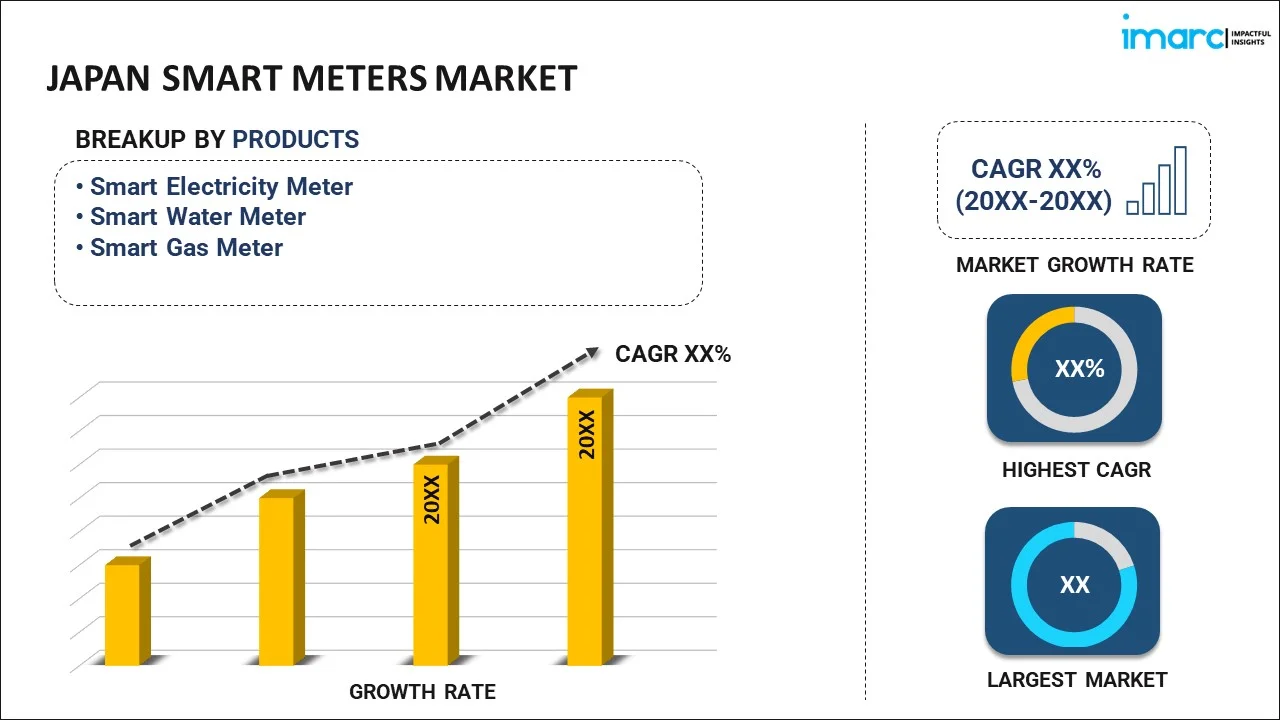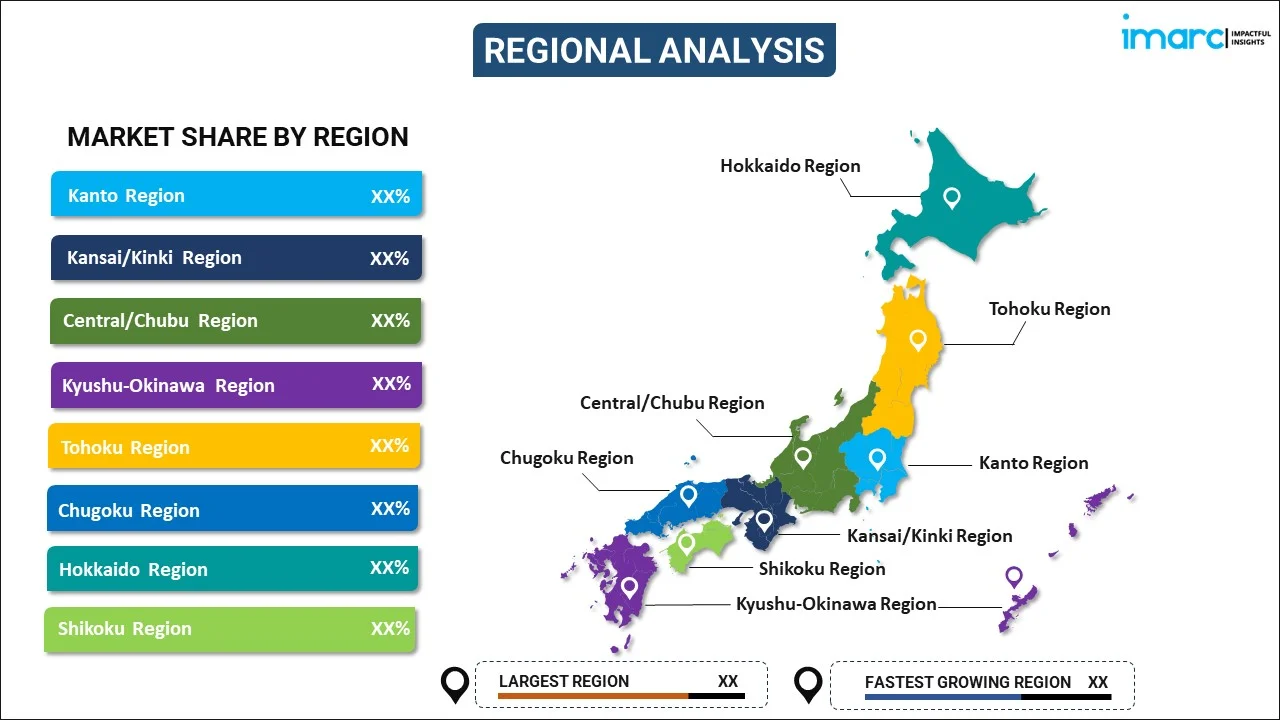
Japan Smart Meters Market Report by Product (Smart Electricity Meter, Smart Water Meter, Smart Gas Meter), Technology (AMI (Advanced Metering Infrastructure), AMR (Automatic Meter Reading), End Use (Residential, Commercial, Industrial), and Region 2025-2033
Market Overview:
Japan smart meters market size reached USD 1.22 Billion in 2024. Looking forward, IMARC Group expects the market to reach USD 2.44 Billion by 2033, exhibiting a growth rate (CAGR) of 8% during 2025-2033. The growing awareness of climate change and environmental sustainability, which has led to increased demand for smart meters to facilitate more efficient energy usage as well as reduce carbon emissions and environmental impact, is driving the market.
|
Report Attribute
|
Key Statistics
|
|---|---|
|
Base Year
|
2024 |
|
Forecast Years
|
2025-2033 |
|
Historical Years
|
2019-2024
|
| Market Size in 2024 | USD 1.22 Billion |
| Market Forecast in 2033 | USD 2.44 Billion |
| Market Growth Rate (2025-2033) | 8% |
Smart meters are advanced devices used to measure and monitor electricity and gas consumption in homes and businesses. Unlike traditional meters, smart meters provide real-time data on energy usage and enable two-way communication between consumers and utility companies. These devices offer several advantages. They allow consumers to track their energy consumption more accurately, helping them make informed decisions to reduce energy use and save money. Smart meters also eliminate the need for manual meter readings, reducing human errors and operational costs for utility providers. Furthermore, smart meters enable time-of-use pricing, encouraging consumers to use electricity during off-peak hours when it is cheaper and more environmentally friendly. They also support the integration of renewable energy sources and improve grid management by providing valuable data for optimizing energy distribution. In summary, smart meters enhance energy efficiency, reduce costs, and contribute to a more sustainable energy future by providing real-time data and enabling better communication between consumers and utilities.
Japan Smart Meters Market Trends:
The smart meters market in Japan is experiencing significant growth due to a confluence of key drivers. Firstly, the increasing regional emphasis on energy efficiency and sustainability has propelled the adoption of smart meters. These devices empower consumers with real-time insights into their energy consumption, fostering a culture of conservation. Furthermore, technological advancements in the field of IoT (Internet of Things) and communication networks have provided a robust foundation for smart meters. The integration of smart grids, in particular, has been a game-changer, enabling two-way communication between utilities and consumers, enhancing reliability, and reducing operational costs. Additionally, the rising importance of remote monitoring and control further accelerates smart meter adoption as utilities seek to enhance their operational resilience. In conclusion, the smart meters market in Japan is surging forward due to a combination of environmental concerns, regulatory mandates, technological innovations, and the need for resilient infrastructure, making it a pivotal component of the modern energy landscape.
Japan Smart Meters Market Segmentation:
IMARC Group provides an analysis of the key trends in each segment of the market, along with forecasts at the country level for 2025-2033. Our report has categorized the market based on product, technology, and end use.
Product Insights:

- Smart Electricity Meter
- Smart Water Meter
- Smart Gas Meter
The report has provided a detailed breakup and analysis of the market based on the product. This includes smart electricity meter, smart water meter, and smart gas meter.
Technology Insights:
- AMI (Advanced Metering Infrastructure)
- AMR (Automatic Meter Reading)
A detailed breakup and analysis of the market based on the technology have also been provided in the report. This includes AMI (advanced metering infrastructure) and AMR (automatic meter reading).
End Use Insights:
- Residential
- Commercial
- Industrial
The report has provided a detailed breakup and analysis of the market based on the end use. This includes residential, commercial, and industrial.
Regional Insights:

- Kanto Region
- Kansai/Kinki Region
- Central/ Chubu Region
- Kyushu-Okinawa Region
- Tohoku Region
- Chugoku Region
- Hokkaido Region
- Shikoku Region
The report has also provided a comprehensive analysis of all the major regional markets, which include Kanto Region, Kansai/Kinki Region, Central/ Chubu Region, Kyushu-Okinawa Region, Tohoku Region, Chugoku Region, Hokkaido Region, and Shikoku Region.
Competitive Landscape:
The market research report has also provided a comprehensive analysis of the competitive landscape in the market. Competitive analysis such as market structure, key player positioning, top winning strategies, competitive dashboard, and company evaluation quadrant has been covered in the report. Also, detailed profiles of all major companies have been provided.
Japan Smart Meters Market Report Coverage:
| Report Features | Details |
|---|---|
| Base Year of the Analysis | 2024 |
| Historical Period | 2019-2024 |
| Forecast Period | 2025-2033 |
| Units | Billion USD |
| Scope of the Report | Exploration of Historical Trends and Market Outlook, Industry Catalysts and Challenges, Segment-Wise Historical and Future Market Assessment:
|
| Products Covered | Smart Electricity Meter, Smart Water Meter, Smart Gas Meter |
| Technologies Covered | AMI (Advanced Metering Infrastructure), AMR (Automatic Meter Reading) |
| End Uses Covered | Residential, Commercial, Industrial |
| Regions Covered | Kanto Region, Kansai/Kinki Region, Central/ Chubu Region, Kyushu-Okinawa Region, Tohoku Region, Chugoku Region, Hokkaido Region, Shikoku Region |
| Customization Scope | 10% Free Customization |
| Post-Sale Analyst Support | 10-12 Weeks |
| Delivery Format | PDF and Excel through Email (We can also provide the editable version of the report in PPT/Word format on special request) |
Key Questions Answered in This Report:
- How has the Japan smart meters market performed so far and how will it perform in the coming years?
- What has been the impact of COVID-19 on the Japan smart meters market?
- What is the breakup of the Japan smart meters market on the basis of product?
- What is the breakup of the Japan smart meters market on the basis of technology?
- What is the breakup of the Japan smart meters market on the basis of end use?
- What are the various stages in the value chain of the Japan smart meters?
- What are the key driving factors and challenges in the Japan smart meters?
- What is the structure of the Japan smart meters market and who are the key players?
- What is the degree of competition in the Japan smart meters market?
Key Benefits for Stakeholders:
- IMARC’s industry report offers a comprehensive quantitative analysis of various market segments, historical and current market trends, market forecasts, and dynamics of the Japan smart meters market from 2019-2033.
- The research report provides the latest information on the market drivers, challenges, and opportunities in the Japan smart meters market.
- Porter's five forces analysis assist stakeholders in assessing the impact of new entrants, competitive rivalry, supplier power, buyer power, and the threat of substitution. It helps stakeholders to analyze the level of competition within the Japan smart meters industry and its attractiveness.
- Competitive landscape allows stakeholders to understand their competitive environment and provides an insight into the current positions of key players in the market.
Need more help?
- Speak to our experienced analysts for insights on the current market scenarios.
- Include additional segments and countries to customize the report as per your requirement.
- Gain an unparalleled competitive advantage in your domain by understanding how to utilize the report and positively impacting your operations and revenue.
- For further assistance, please connect with our analysts.
 Inquire Before Buying
Inquire Before Buying
 Speak to an Analyst
Speak to an Analyst
 Request Brochure
Request Brochure
 Request Customization
Request Customization




.webp)




.webp)












